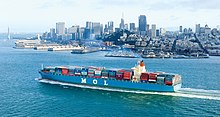Admiralty law or maritime law is a body of law that governs nautical issues and private maritime disputes. Admiralty law consists of both domestic law on maritime activities, and private international law governing the relationships between private parties operating or using ocean-going ships. While each legal jurisdiction usually has its own legislation governing maritime matters, the international nature of the topic and the need for uniformity has, since 1900, led to considerable international maritime law developments, including numerous multilateral treaties.
The International Regulations for Preventing Collisions at Sea 1972, also known as Collision Regulations (COLREGs), are published by the International Maritime Organization (IMO) and set out, among other things, the "rules of the road" or navigation rules to be followed by ships and other vessels at sea to prevent collisions between two or more vessels. COLREGs can also refer to the specific political line that divides inland waterways, which are subject to their own navigation rules, and coastal waterways which are subject to international navigation rules. They are derived from a multilateral treaty called the Convention on the International Regulations for Preventing Collisions at Sea, also known as Collision Regulations of 1960.

The Marchioness disaster was a collision between two vessels on the River Thames in London in the early hours of 20 August 1989, which resulted in the deaths of 51 people. The pleasure boat Marchioness sank after being hit twice by the dredger Bowbelle at about 1:46 am, between Cannon Street railway bridge and Southwark Bridge.
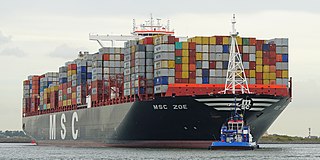
Mediterranean Shipping Company S.A., branded as MSC, is an international shipping line founded by Gianluigi Aponte in Italy in 1970. The company is owned by the Aponte family with its headquarters in Geneva, Switzerland, since 1978. It is the world's largest container shipping company by both fleet size and cargo capacity, controlling 20% of global container capacity as at July 2024.

HNoMS Helge Ingstad was a Fridtjof Nansen-class frigate of the Royal Norwegian Navy. The vessel was ordered on 23 June 2000 and constructed by Navantia in Spain. The ship was launched on 23 November 2007 and commissioned on 29 November 2009. Named for Helge Ingstad, a Norwegian explorer, the Fridtjof Nansen class are capable of anti-air, anti-submarine and surface warfare.

HMS Bangor is a Sandown-class minehunter commissioned by the Royal Navy in 2000. Designed to hunt naval mines in depths of up to 200 m (660 ft) using the Sonar 2093 Variable Depth Sonar (VDS) meaning that she can conduct mine clearance operations throughout the continental shelf. She is named after the Northern Ireland seaside city of the same name, and the second Royal Navy vessel to bear the name. As of January 2024, she was the last vessel of her class in active Royal Navy service.

HMS Penzance was a Sandown-class minehunter commissioned by the Royal Navy in 1998. She was named after the seaside town of Penzance in Cornwall, and was the fourth vessel to bear the name. She was decommissioned in January 2024.

The Prestige oil spill occurred off the coast of Galicia, Spain in November 2002, caused by the sinking of the 26-year-old, structurally deficient oil tanker MV Prestige, carrying 77,000 tonnes of heavy fuel oil. During a storm, it burst a tank on 13 November, and French, Spanish, and Portuguese governments refused to allow the ship to dock. The vessel subsequently sank on 19 November, about 210 kilometres (130 mi) from the coast of Galicia. It is estimated that it spilled 60,000 tonnes or a volume of 67,000 m3 (17.8 million US gal) of heavy fuel oil.
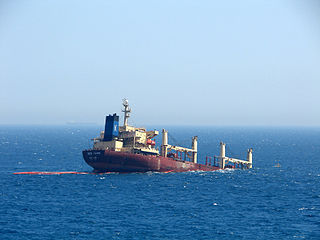
MV New Flame was a Panamanian bulk-carrier cargo ship. It collided with an oil tanker off Europa Point, the southernmost tip of Gibraltar on 12 August 2007, and ended up partially submerged in the Strait of Gibraltar. The vessel broke into two in December 2007 amid numerous unsuccessful recovery efforts. The cargo was salvaged and the stern section removed for scrap. Following the crew's rescue, the captain was arrested for having departed without authorisation. Charges of endangering shipping were later dropped.

The SS Superior City was considered a pioneer vessel at her launching in 1898. She was the largest vessel ever built on freshwater at that time. She sailed the Great Lakes for twenty-two years until she sank after a collision in 1920 with the steamer Willis L. King in Whitefish Bay of Lake Superior that resulted in the loss of 29 lives. Controversy was immediate over the collision. It was subsequently ruled that the captains of both ships failed to follow the “rules-of-the-road”. Controversy started again in 1988 when the Great Lakes Shipwreck Historical Society produced a video called "Graveyard of the Great Lakes" that included extensive footage of the skeletons of the Superior City crew. The controversy continued as late as 1996 over artifacts removed from her wreck. She is now a protected shipwreck in the Whitefish Point Underwater Preserve.

SS Comet was a steamship that operated on the Great Lakes. Comet was built in 1857 as a wooden-hulled propeller-driven cargo vessel that was soon adapted to carry passengers. It suffered a series of maritime accidents prior to its final sinking in 1875 causing the loss of ten lives. It became known as the only treasure ship of Lake Superior because she carried 70 tons of Montana silver ore when it sank. The first attempts to salvage its cargo in 1876 and 1938 were unsuccessful. Comet was finally salvaged in the 1980s when the Great Lakes Shipwreck Historical Society illegally removed artifacts from the wreck. The artifacts are now the property of the State of Michigan and are on display as a loan to the Great Lakes Shipwreck Museum. The fate of her silver ore cargo is unknown. Comet's wreck is now protected by the Whitefish Point Underwater Preserve as part of an underwater museum.
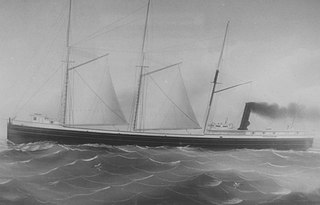
The John M. Osborn was a wooden steam barge that sank in Lake Superior in 1884 with the loss of five lives. The Osborn was just 2 years old when the larger, steel-hulled Alberta, which was called a "steel monster" and "terror of the lakes", rammed her. The wreck of the Osborn was discovered 100 years after her sinking. The wreck was illegally salvaged in the 1980s. Many of Osborn's artifacts became the property of the State of Michigan after they were seized from Great Lakes Shipwreck Museum. The State allows the museum to display the artifacts as a loan. The wreck of the Osborn is now protected by the Whitefish Point Underwater Preserve as part of an underwater museum.
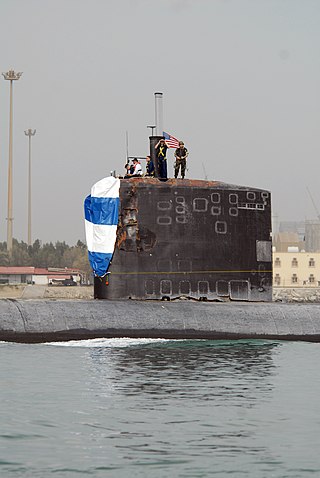
The USS Hartford and USS New Orleans collision was a collision between the United States Navy Los Angeles-class submarine USS Hartford and the United States Navy San Antonio-class amphibious transport dock USS New Orleans on 20 March 2009. It occurred in the Strait of Hormuz, between Iran, the United Arab Emirates, and Musandam, an exclave of Oman. Both ships incurred millions of dollars' worth of damage in the collision which required repair in drydock.
The Erika legislative packages of the European Union are maritime laws intended to improve safety in the shipping industry and thereby reduce environmental damage to the oceans.
The Venpet–Venoil collision was a maritime accident involving sister supertankers; the Liberian-registered Venoil and Venpet, in dense fog off the coast of South Africa on 16 December 1977. The tankers were travelling in opposite directions; the Venoil fully laden with over 250,000 tonnes of crude oil bound for Halifax, Canada, and the Venpet, travelling in ballast, headed for Kharg Island, Iran. The Venoil ploughed into the Venpet, eventually leading to the spilling of approximately 26,600–30,500 tonnes of crude oil. The tankers were sister ships owned and operated by Bethlehem Steel Corporation. Both ships were crewed by Taiwanese sailors.

SS (RMS) Peveril (I) No. 76307 – the first vessel in the company's history to be so named – was a packet steamer which was operated by the Isle of Man Steam Packet Company until she sank off Douglas following a collision with SS Monarch in 1899.

MSC Flaminia is a German container ship which caught fire on 14 July 2012, claiming three lives and forcing the crew to abandon ship in the middle of the Atlantic Ocean. After the fire had been brought under control, the stricken container ship was towed to Europe and arrived at Wilhelmshaven, Germany, on 9 September 2012. In March 2013, she departed Wilhelmshaven for Mangalia, Romania for repairs which were finished in July 2014. The ship is currently sailing under the name CMA CGM San Francisco.
The MV Alam Pintar and FV Etoile des Ondes collision took place in the English Channel in 2009 and involved the Singapore bulk carrier Alam Pintar and the UK fishing vessel Etoile des Ondes. The fishing vessel sank and, although three of its four crew were rescued, one member, Chris Wadsworth, was never found. The bulk carrier continued on its passage although its crew knew of the collision and later made attempts to hide the fact of their knowledge. Three other vessels nearby did not respond to Etoiles' distress calls, even though these were also broadcast by the coastguards. The rescue was eventually carried out by the ferry MV Norman Voyager. The UK's Marine Accident Investigation Branch (MAIB) carried out a full investigation of the incident and issued a damning report. Safety recommendations were made but under maritime law national governments have no authority over foreign-flagged vessels more than 12 nautical miles (22 km) from their coasts. No country attempted any criminal prosecutions.
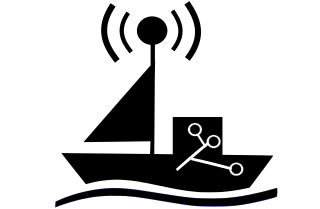
Autonomous cargo ships, also known as autonomous container ships or maritime autonomous surface ships (MASS), are crewless vessels that transport either containers or bulk cargo over navigable waters with little or no human interaction. Different methods and levels of autonomy can be achieved through monitoring and remote control from a nearby manned ship, an onshore control center or through artificial intelligence and machine learning, letting the vessel itself decide the course of action.
